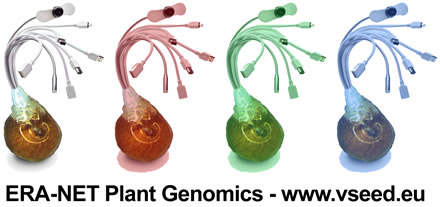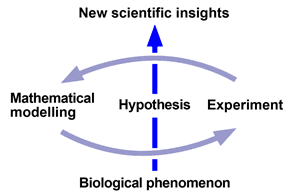|
Aims of the vSEED ('virtual seed') project
- The vSEED project aims to provide a dynamic
mathematical description of seed germination,
dormancy and after-ripening by focussing
on the key seed compartments the radicle and
endosperm. This interdisciplinary project will
analyse the comparative biology of the closely
related Brassicaceae species Arabidopsis
thaliana and Lepidium sativum (garden cress),
using engineering, imaging, identification of
key transcriptome networks, modelling, and
post-genomics approaches to develop a
virtual germinating seed.
- We propose that germination is an ideal exemplary subject for the
integration of new technologies and for developing molecular plant
biomechanics in conjunction with dynamic mathematical modelling. The vSEED project is therefore an highly interdisciplinary plant systems biology project.
- As part of the ERA-NET Plant Genomics (ERA-NET PG), the joint project vSEED is working toward the goal of achieving a profound molecular understanding of plants. ERA-Net PG is a collaborative network composed of European ministries, funding organizations, and national research councils with research programs in the area of plant genomics (www.erapg.org). The network currently includes 23 partners in 17 European countries.
- vSEED is a winner of the second competition, the ERA-Net PG call in January 2008. vSEED ranked number 1 of the 54 applications of the 2008 call. The ERA-NET PG 2008 is sponsoring 12 transnational projects. For the vSEED network 1.7 Mio. Euro is granted for three years.
|
 |
 |

|
The European vSEED consortium - people and labs
Nottingham:
- Mike Holdsworth, Molecular Genetics, Project co-ordinator
michael.holdsworth@nottingham.ac.uk, School of Biosciences, The University of Nottingham, UK
- John King, Modelling and Theoretical Mechanics
john.king@nottingham.ac.uk, School of Mathematical Sciences, The University of Nottingham, UK
- Andy Wood, Statistics
andy.wood@nottingham.ac.uk, School of Mathematical Sciences, The University of Nottingham, UK
- Nicola Everitt, Materials Engineering
nicola.everitt@nottingham.ac.uk, School of Mechanics, Materials and Manufacturing
Utrecht / Wageningen:
- Leonie Bentsink, Quantitative Post-Genomics
L.Bentsink@uu.nl, Utrecht and Wageningen University, The Netherlands
Leeds:
- Paul Knox,
Cell Wall Biology, Cell Wall Lab
j.p.knox@leeds.ac.uk, Paul Knox Cell Wall Lab, University of Leeds, UK
Freiburg:
- Gerhard Leubner,
Physiological Genetics and Bioengineering, The Seed Biology Place
gerhard.leubner@biologie.uni-freiburg.de, Botany/Plant Physiology, University of Freiburg, Germany
- Thomas Speck,
Bionics and Biomimetics, Botanical Garden
thomas.speck@biologie.uni-freiburg.de, Functional Plant Morphology, University of Freiburg, Germany

|
vSEED in Freiburg - people and work
Our task in Freiburg within the vSEED project is to investigate the biomechanics of Lepidium sativum (cress) and Arabidopsis seed germination. This includes the establishments of methods and measurements of
- puncture-force of micropylar endosperm of cress and Arabidopsis
- tensile strength of strips of the micropylar endosperm of cress
- cell extension and/or separation during radicle growth and endosperm weakening of cress and Arabidopsis
- vacuolation and turgor pressure in the micropylar endosperm and radicle of cress and Arabidopsis
- water uptake and volume changes during the germination process of cress and Arabidopsis
- reverse-genetics of cell wall loosening-related genes in both species.
A second focus in our research is an investigation of the early stages of seed germination, that is the processes that precede and lead to testa rupture in Arabidopsis and cress.
People: Tina Steinbrecher as vSEED postdoc and Karin Weitbrecht as vSEED PhD student. vSEED-associated researchers were working on pectin-related aspects of seed germination, published as Scheler et al. (2015).

|
Systems biology as an integrative discipline
 |
|
Systems biology is characterized by quantitative analysis of dynamic interactions between components of a biological system, and between biological systems and their interaction with the environment. Systems biology aims on understanding the behaviour of the system as a whole to enable predictions of its behaviour. Systems biology requires interdisciplinary collaboration between fields like biology, physics, computer science and engineering. Systems biology is an approach by which biological questions are addressed through integrating experiments in iterative cycles with computational modelling, simulation and theory. Modelling is not the final goal, but is a tool to increase understanding of the system, to develop more directed experiments and finally allow predictions. (modified based on G. Miczka, www.fz-juelich.de/ptj/systembiologie).
|
 |
 |
 |
Seed germination as an excellent field for systems biology approaches: In the vSEED application we propose that seed germination is an ideal exemplary subject for the integration of new technologies and for developing molecular plant biomechanics in conjunction with dynamic mathematical modelling. Seed germination is a binary system (output 0 or 1) that cannot go backwards. It is controlled by two biological compartments: the embryo and the covering layers, e.g. testa+endosperm cap for the Brassicaceae Arabidopsis thaliana and Lepidium sativum. Seeds are also ideal for applying an integrative systems biology approach to plant environment interactions, in particular ambient temperature and water availability.
Systems biology in Baden-Württemberg: Brochure (in German) by BIOPRO Baden-Württemberg GmbH about groups working in systems biology.
Download a PDF about the part of brochure describing the vSEED system biology work of the group of Gerhard Leubner at the University of Freiburg.
For the entire brochure see the BIOPRO portal.

|
Press information about vSEED

|
| |
|
 |
| |
|
|
|

|


 |

